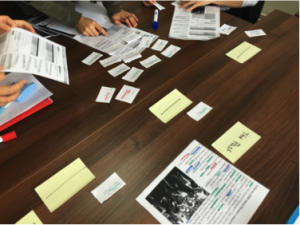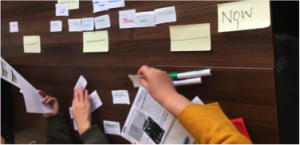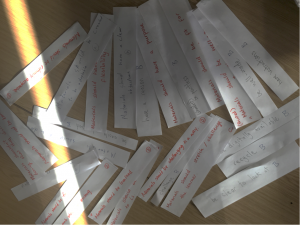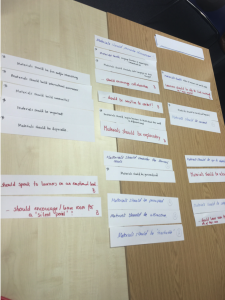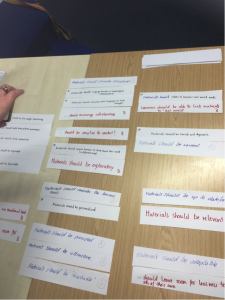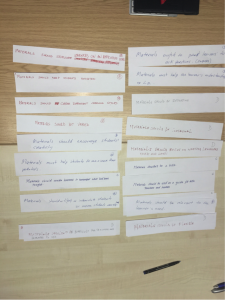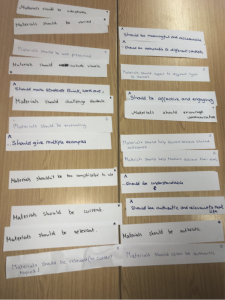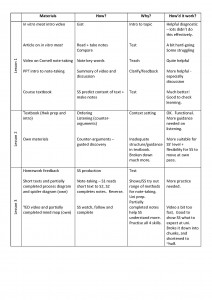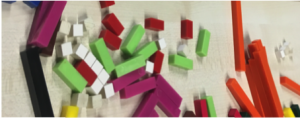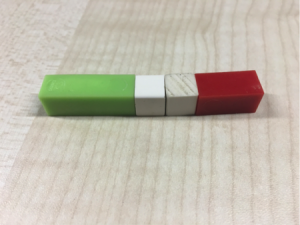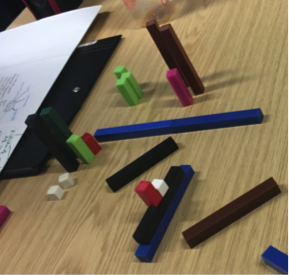Corpora are an example of technology that is widely used in EAP, but perhaps not to its full potential. This was the subject I wrote about in the Methodology module last term, but I thought it was equally relevant here.
The Lexical Approach and Use of Corpora in EAP
Identification
In the fourth workshop of the Methodology module, each group gave a presentation on an extension or alternative to CLT, with Lucinda, Victoria and I being assigned the lexical approach to introduce. I must admit that it was an approach that I had not really heard of before. While researching it, however, it made a lot of sense to me. This is partly because in my teaching, as well as in learning languages myself, I have unwittingly been applying some of the principles of the lexical approach.
- Teaching or learning vocabulary in chunks, not just as lone words
- Contextualising the presentation of words and grammar points, and grouping according to function/context
- Getting students to notice real language and its co-text in authentic materials – not how language can be used, but how it is
The main emphasis of the approach is to recognise the importance of lexis for communicative competency – as opposed to grammatical accuracy – with the idea of language being ‘grammaticalised lexis’ (Lewis 1993).
It was great to read about the theory and application of some of the practices I had already been using Lewis (1993, 1997). The approach’s compatibility with other ELT methodologies and CLT make it particularly appealing to me. Following my presentation of a few ideas to make coursebook-based syllabuses fit better with the lexical approach, I started to think about it with greater focus on my own context: English for Academic Purposes (EAP). For the purpose of this SOR, I have included the points that have made me reflect most upon my own teaching and on how I could integrate use of corpora into my writing lessons.
Reflection – Corpora in EAP
I have been teaching EAP in higher education for over six years now, so when I initially read about the lexical approach’s emphasis on observing real language and that corpora are a valuable tool for this (Lewis 1993, 2000), I immediately thought of the Academic Word List (AWL, Coxhead 2000). I have used the AWL previously to focus vocabulary teaching, but have not used – and was to some extent unaware of – the full potential of corpus analysis tools. From my reading this seems to be the case for a lot of practitioners (see Thompson 2006).
Although the frequency of language being used (the organising principle for corpus-based word lists) is important, engaging directly with corpus data can tell us – teachers and students alike – much more than that. Word lists in general fail to recognise the importance of collocation, which is key to the lexical approach. Corpus-based word lists alone do not show the word in context or represent the frequency of different senses of the word. I seem to have only seen the tip of the iceberg when it comes to how corpora can be useful to all language teaching, not just EAP. Concordance lines can be used to learn about
- differences in words used in speaking and writing, and in different contexts
- the likely phraseology (collocation and colligation) used with certain words
- a word’s function in organising and managing discourse (McCarten 2007).
If corpora are to be used to learn vocabulary in the lexical approach, all of these, along with the likely semantic prosody of a word should be taken into account (Hoey 2000). Looking at concordance lines in data-driven learning (DDL) activities, may shorten the vocabulary-learning process (O’Keeffe et al 2007, p24) of collecting mental concordance data as described by Hoey (2000, p240). It is this noticing of these chunks and patterns that aids fluency, cohesion and coherence in students’ own production.
So far corpus data has influenced reference works much more than it has directly influenced what happens in the classroom (Stubbs 2004 cited in Flowerdew 2015). In particular, EAP and ESP have been the focus of the majority of classroom-based research in ELT thus far (Flowerdew 2015; O’Keeffe et al 2007). O’Keeffe et al (2007, p24) suggests that the volume of DDL materials available attests to its popularity among language teachers. Flowerdew (2015, p108) describes the concern that DDL activities at lower levels may be problematic, but suggests that corpus data be used hands-on with students at different levels, for example by limiting the number of samples given.
DDL appears to have positive effects for learners (Flowerdew 2015). However, there is significant debate as to whether a core academic vocabulary spanning different disciplines exists (ibid.). Research has found that even high-frequency academic words show semantic variation and different phraseological tendencies dependent on discipline (ibid; Hyland and Tse 2007; O’Keeffe et al 2007). It is clear that failing to use discipline specific corpora would fail to fully prepare EAP students for their future studies.
Lewis’ recommendation that awareness raising involves having students compare their own work with some norm (1993, p150) begs the question ‘which norm?’ What should be the basis of the corpus?
- Journal articles and books written by academics
- What the students are likely to read
- Native-students’ work (MICUSP and BAWE corpus)
- Non-native learners’ work – these corpora provide valuable insight into the difficulties L2 learners have with academic English (see Gilquin et al 2007).
Development
Short Term
- Get students to highlight high-frequency words in subject specific texts, and use DDL based on AWL and academic corpora to highlight register, and discipline specific corpora with groups that are predominantly separated by subject. This will help students identify patterns, gain fluency in their productive skills, and better prepare them for their university studies.
- With mixed groups, encourage students to compare use of AWL words in their specific subjects. This will promote learner autonomy.
Long Term
- Make a corpus of my students’ work to
- help to identify error patterns/difficulties and target DDL activities accordingly
- use to compare learners’ language with lexical chunks commonly used by native speakers of English at different levels using the BAWE corpus.
I will try to involve students and subject teachers in the selection of materials for the corpus to increase student engagement and ensure that the types of text included are relevant to their future studies.
References
Coxhead, A., 2000, A new academic word list, TESOL Quarterly, 34, pp213-238.
Flowerdew, L., 2015, Corpus-based research and pedagogy in EAP: From lexis to genre, in Language Teaching, 48, pp99-116.
Gillet, A., (2015). Using English for Academic Purpose, Available from <http://www.uefap.net/index.php/vocabulary/vocabulary-selecting/435-vocabulary-selecting-specific-subjects>, accessed on 29 October 2015.
Gilquin, G. Granger, S. and Paquot, M., (2007), Learner Corpora: The missing link in EAP pedagogy, in Journal of English for Academic Purposes, 6, pp319-335.
Hyland, K., and Tse, 2007, Is There an “Academic Vocabulary”?, in TESOL Quarterly, 41 (2), pp235-253.
Hoey, M., 2000, A world beyond collocation: new perspectives on vocabulary teaching in M. Lewis (ed), Teaching collocation: further developments in the lexical approach. Hove: Language Teaching Publications, pp224–43.
Kilgariff et al., 2015, BAWE (British Academic Written English) Corpus on Sketch Engine, Available from <https://the.sketchengine.co.uk/open/>, accessed on 29 October 2015.
Lewis, M., 1993, The lexical approach: the state of ELT and a way forward, Hove: Language Teaching Publications.
Lewis, M., 1997, Implementing the Lexical Approach: Putting Theory into Practice, Hove: Language Teaching Publications.
Lewis, M. (ed), 2000, Teaching collocation: further developments in the lexical approach, Hove: Language Teaching Publications.
McCarten, J. 2007, Teaching Vocabulary: Lessons from the Corpus, Lessons for the Classroom, Cambridge: Cambridge University Press.
O’Keeffe, A. McCarthy, M. and Carter, R., 2007, From Corpus to Classroom: Language Use and Language Teaching, Cambridge: Cambridge University Press.
Römer, U. et al., 2010, MICUSP Michigan Corpus of Upper-level Student Papers, Available from <http://micusp.elicorpora.info/>, accessed on 31 October 2015.
Thompson, P., 2006, Assessing the contribution of corpora to EAP practice, Available from <http://www.reading.ac.uk/internal/appling/thompson_macedonia.pdf>, accessed on 30 October 2015.

